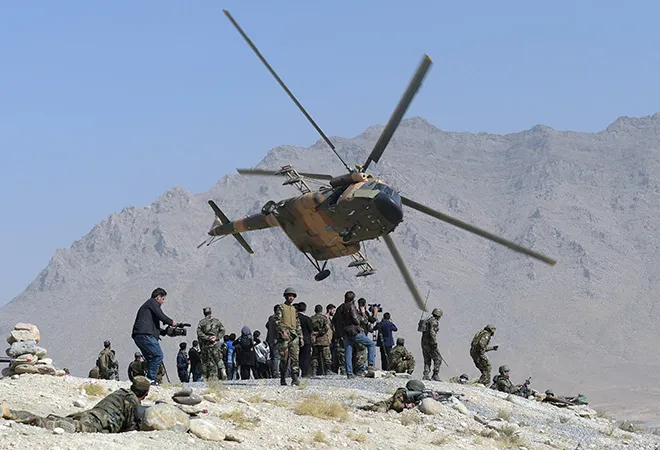
The United States (US), by mid-June, has withdrawn more than 50 percent of its military presence in Afghanistan, according to the Pentagon, as the administration of President Joe Biden speedily works towards a full withdrawal by the set and symbolic date of September 11, 2021. The expedited American exit has thrown both Afghanistan and US policies into a chaotic mess. There is little clarity on the future US role in counterterror and counterinsurgency (COIN) operations in the country, an eventuality of the fall of Kabul once again; and perhaps most importantly, the future of the operability and vulnerabilities of the Afghan military fighting against an emboldened Taliban.
The Afghan Air Force (AAF) remains one of the most significant tools in fighting against the multiple insurgencies on the ground. However, the US withdrawal may throw a ner in the workings of the air force as well, with more than 18,000 contractors aiding the efforts and keeping the flying machines running optimally also exiting. This could significantly diminish the capacity of the AAF, as it operates a number of US-made aircraft such as the UH-60 Black Hawk and MD500 Defender helicopters along with fixed-wing counter-insurgency specialist aircraft like the A-29 Super Tucano, all relying heavily on Western contractors for their upkeep. Reports indicate that alternatives to plug these gaps have still not been organised, which could potentially leave the AAF crippled.
The apparent lack of foresight by the US is not new. The second major theatre of war for the US in its post-9/11 ‘war on terror’ campaign, Iraq, also witnessed a similar Washington DC–made crisis. Baghdad purchased and operated expensive F-16 fighter aircraft from the US as part of its air force modernisation, despite better, smaller, and more economical options being available as far as COIN operations go. However, much of the F-16 fleet today remains grounded as contractors pulled out of the country due to an increase in rocket attacks by militias against US military bases.
While the US-made aircraft in the AAF are important, it was perhaps a degree of prudence on Kabul’s part to keep a good section of its older, Russian-made helicopter fleet flying at the same time. This has allowed the Afghan forces to continue critical work, such as aiding counterterror forces on the ground, evacuating injured troops and so on. Much of this fleet comprises of Mil Mi-17 medium-lift helicopters, that by the look of things, may become the frontline mainstay for the AAF moving forward. The fleet also includes four Mi-24V attack helicopters donated by India to bolster Kabul’s counterterror operations. From a capacity perspective, these replaced four older Mi-35s that India had donated from the Indian Air Force (IAF) fleet in 2015-16. However, India’s contribution was limited only to providing the helicopters and training the aircrews. Further sustainment of the aircraft was to be handled by the AAF or the Operation Resolute Support coalition. This was obviously a less-than-ideal arrangement, and the subsequent status of these attack helicopters remains unclear, with some recent (unverifiable) chatter suggesting the machines are largely grounded due to issues with maintenance and spares.
While the US-made aircraft in the AAF are important, it was perhaps a degree of prudence on Kabul’s part to keep a good section of its older, Russian-made helicopter fleet flying at the same time. This has allowed the Afghan forces to continue critical work, such as aiding counterterror forces on the ground, evacuating injured troops and so on
Opportunity for India
The renewed prominence of the AAF’s older Russian fleet centred on the Mi-17 raises an interesting question and, perhaps, a proposition. Can India, and in particular the IAF, which operates hundreds of Mi-17s in its fleet, help the AAF maintain a level of operability using its Russian fleet that allows it to continue with a significant section of its counterterror and COIN operations, supporting Afghan troops on the ground despite a full US withdrawal?
Outside the country of origin, Russia, the IAF likely has the most experience flying and sustaining the Mi-17 and its variants. Indian pilots are familiar with the machine’s characteristics in precisely the kind of harsh and demanding conditions it faces in Afghanistan, from their years of operating in India’s equally unforgiving mountain frontiers. The IAF’s engineers are intimately familiar with all the helicopter’s technical characteristics, including any foibles that may crop up, and are capable of everything from frontline servicing to overhaul. In fact, the newest Mi-17 variant in India, the Mi-17V-5, is already operated by Afghanistan, and is assembled and overhauled at the IAF’s No. 3 Base Repair Depot in Chandigarh.
Given that the Mi-17 is by far the most useful and versatile of all the AAF’s aircraft, it stands to reason that this is the aviation capability the Afghan state will be least willing to lose. While the IAF might loathe to give away important helicopters in the near-term, specifically with multiple active challenges on its borders from Pakistan to Myanmar, in the longer-term, it is likely that the IAF will be ordering more Mi-17V-5s and can then make up any numerical shortfalls. What the IAF can certainly do with near immediate effect is engage with the AAF on their near-term training and sustainment requirements and begin to secure these.
In the best case scenario, India’s underutilised capacity for military diplomacy will secure a foothold in a crucial regional country in a time of serious upheaval with a minimal capacity commitment.
The specific contours of the IAF-AAF engagement can be circumscribed depending on how far, or not, the Indian government is willing to go in Afghanistan. In the best case scenario, India’s underutilised capacity for military diplomacy will secure a foothold in a crucial regional country in a time of serious upheaval with a minimal capacity commitment. And in the longer-term, who knows, perhaps there will be a time when Indian-made helicopters such as the HAL Dhruv, specialised for high altitudes, could be offered to wear the AAF colours?
Conclusion
As the US continues to send mixed signals on what its post-withdrawal strategy is, the current AAF supremacy in the skies over Afghanistan could be contested, as reports suggest that some factions of the Taliban may have invested in surface-to-air missiles. Even without such a capacity, the Taliban had claimed shooting down an AAF Mi-17 in April. While India’s kinetic options are limited, providing technical expertise to make sure the AAF’s Mi-17 keep operating, providing critical firepower to the very idea of democracy that India has invested heavily in Kabul, may not be the worst project to put some weight behind. And as scholar Rajesh Rajagopalan notes in context to India’s foreign policy: “Ideas, as important as they are, will not go anywhere unless these ideas have got material power backing them.”
The views expressed above belong to the author(s). ORF research and analyses now available on Telegram! Click here to access our curated content — blogs, longforms and interviews.




 PREV
PREV



